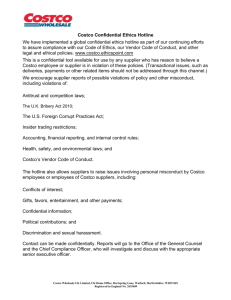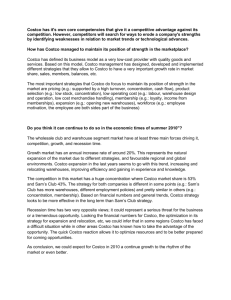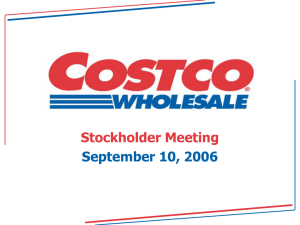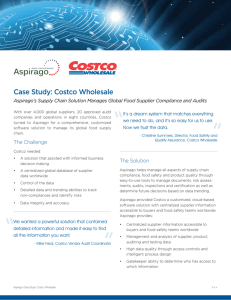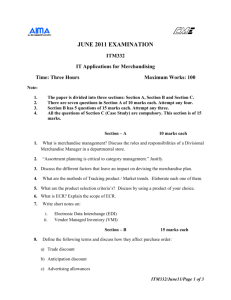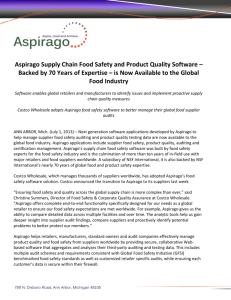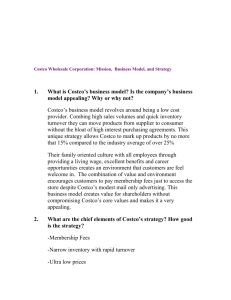an_example - Smartwriting Centre
advertisement
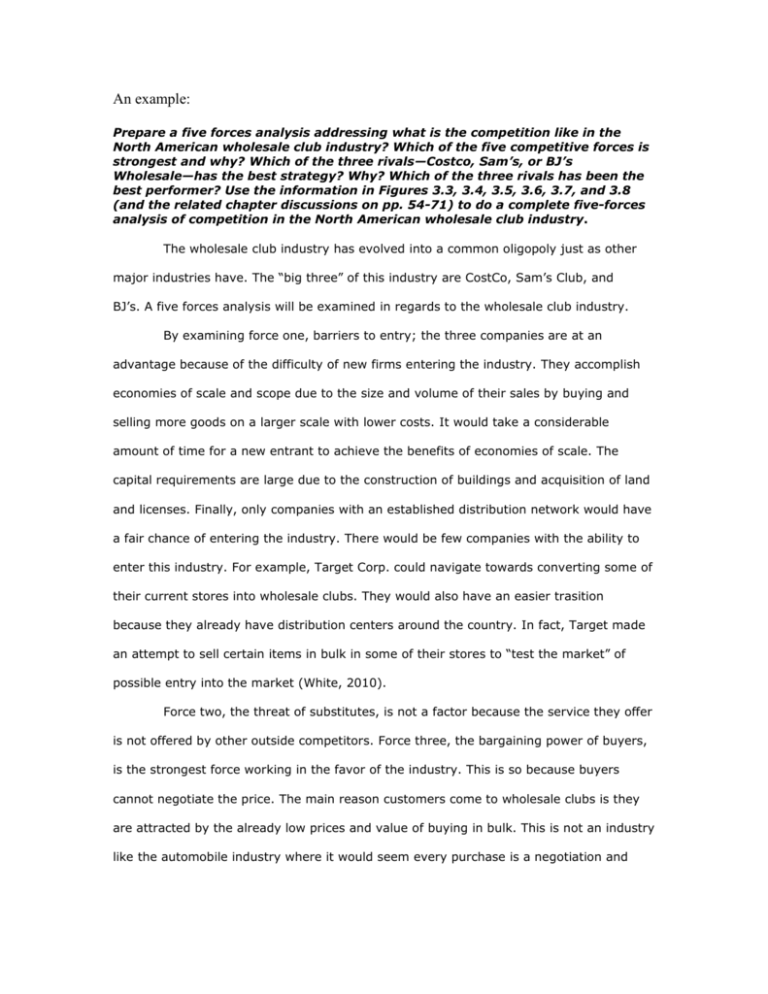
An example: Prepare a five forces analysis addressing what is the competition like in the North American wholesale club industry? Which of the five competitive forces is strongest and why? Which of the three rivals—Costco, Sam’s, or BJ’s Wholesale—has the best strategy? Why? Which of the three rivals has been the best performer? Use the information in Figures 3.3, 3.4, 3.5, 3.6, 3.7, and 3.8 (and the related chapter discussions on pp. 54-71) to do a complete five-forces analysis of competition in the North American wholesale club industry. The wholesale club industry has evolved into a common oligopoly just as other major industries have. The “big three” of this industry are CostCo, Sam’s Club, and BJ’s. A five forces analysis will be examined in regards to the wholesale club industry. By examining force one, barriers to entry; the three companies are at an advantage because of the difficulty of new firms entering the industry. They accomplish economies of scale and scope due to the size and volume of their sales by buying and selling more goods on a larger scale with lower costs. It would take a considerable amount of time for a new entrant to achieve the benefits of economies of scale. The capital requirements are large due to the construction of buildings and acquisition of land and licenses. Finally, only companies with an established distribution network would have a fair chance of entering the industry. There would be few companies with the ability to enter this industry. For example, Target Corp. could navigate towards converting some of their current stores into wholesale clubs. They would also have an easier trasition because they already have distribution centers around the country. In fact, Target made an attempt to sell certain items in bulk in some of their stores to “test the market” of possible entry into the market (White, 2010). Force two, the threat of substitutes, is not a factor because the service they offer is not offered by other outside competitors. Force three, the bargaining power of buyers, is the strongest force working in the favor of the industry. This is so because buyers cannot negotiate the price. The main reason customers come to wholesale clubs is they are attracted by the already low prices and value of buying in bulk. This is not an industry like the automobile industry where it would seem every purchase is a negotiation and most buyers go into purchase situation with a price haggling mind-set. The prices are set as they are and the buyers accept the prices. Force four, the bargaining power of suppliers could come into play if a more favorable opportunity presents itself in the general retail industry. Wholesale clubs offer only a percentage of the products (ranging from 4000-8000 SKUs) that a general retailer does (100,000+ SKUs). For example, if Proctor & Gamble (P&G), the makers of Crest toothpaste, decides that it is not beneficial to their company to sell Crest wholesale, they could apply pressure to the clubs by pulling their product. A key strategy of CostCo is aimed squarely at selling top-quality merchandise at prices consistently below what other wholesalers or retailers charge (Thompson, 2010). To not carry a popular product such as Crest could cause sales to decline especially if numerous suppliers apply the same pressure. The clubs would lose credibility of carrying top-quality merchandise. The fifth and final force, rivalry among existing players, is not a major factor. The analysis of the case shows that sales have remained steady at all three across the board. CostCo net sales for 2009, were 71 billion, roughly $1 billion lower than 2008. Sam’s nets sales were $46 billion, off only 0.7% from the previous year. BJ’s actually increased net sales around $1 billion each of the past two years. Contributing factors to the success of each is that each offers a niche market within a niche market. Simply put, each club offers subtle yet distinctly impactful differences than the other two. CostCo, the runaway leader presently, offers the “treasure hunt” deals where extreme bargains are offered for short, unannounced periods of time. This creates buzz amongst customers by enticing them to return on a consistent basis to explore what “treasures” are available. BJ’s sets itself apart by being the only club among the three to accept manufacturer’s coupons. They also are the only club to accept all four major credit cards, MasterCard, Visa, Discover, and American Express, at all locations. They also offer a broader assortment of items as compared to Sam’s and CostCo (approximately 7,000 SKUs). The analysis shows that CostCo is the runaway leader of the industry. Annual net sales are nearly double of the nearest competitor, Sam’s Club. It would appear that they also currently have the best strategy. The no frills, low margin markup strategy has been sustainable and grown the company over the past 5 years. Not only have they added warehouse locations, but since 2000, they have increased membership by 1.5 million just in business members. They also have pay far better wages and predominately promote from within. This helps develop and maintain a strong, knowledgeable, and loyal workforce Do all three warehouse club rivals—Costco, Sam’s, and BJ’s Wholesale—have highly similar strategies? What differences in their strategies are apparent? Does one rival have a better strategy than the others? If so, why? Does one rival have a somewhat weaker strategy than the other two? If so, why? The overall plan of all three wholesalers is the same. Sell items in bulk convincing the consumer that they are ultimately receiving a bigger bargain even if it means enduring higher up-front costs, while at the same time maintaining a separate revenue stream through renewed and new annual membership fees. Aside from that, the analysis shows that they operate distinct strategies. CostCo focuses on growing the membership base to utilize well-strategized merchandising concepts in enticing members to shop on impulse. The presentation is meant to suggest, accurately in many cases, that if you don't jump at the purchase today, you're not likely to get another chance. The fleamarket aspect of CostCo, "the treasure-hunt atmosphere for wow items", has an unmistakable touch of theater (Gertner, 2003). CostCo, along with Sam’s Club, have established beneficial relations with their suppliers to procure the lowest possible costs of merchandise. The leverage these firms hold over their suppliers is immense. Suppliers must cooperate and/or comply with each of the firm’s requirements simply because having their products on the shelves in a CostCo or Sam’s is of great benefit to the supplier. CostCo has also expressed an advantage by catering not only to consumers looking for bargains on everyday average items, rolling out a marketing plan to lure high income shoppers with luxury item merchandise like jewelry and wine. Now value can apply to anything CostCo decides to carry: wine, chandeliers, diamonds, or even fine furniture. It's no longer the case that the sale and the splurge are separate ideas. We can buy into the lush life and the not-so-lush life at the same time, and in the same place (Gertner, 2003). Some analysts have believed for several years that BJ’s outperforms the other two clubs, Sam's and Costco, even though both dwarf it in sales more than eight times over. Sales grew 13% to $2.93 billion from the year ended Jan. 31, 1997, from $1.8 billion four years earlier. One strategy that sets BJ’s apart from the other two is that they accept manufacturer’s coupons whereas the other two do not (Halverson, 1997). BJ’s also caters to ethnic communities in urban and suburban regions. BJ’s micromarkets food, carrying Kosher foods in markets with a large Jewish population and Italian ethnic foods in markets where many Italian Americans live and shop. Neither Sam's nor Costco offers such ethnic foods variations (Halverson, 1997). If anything stands out as a weak strategy, it would appear to be Sam’s Club, as they look ride the coattails and carried by the low-cost reputation of Walmart.
